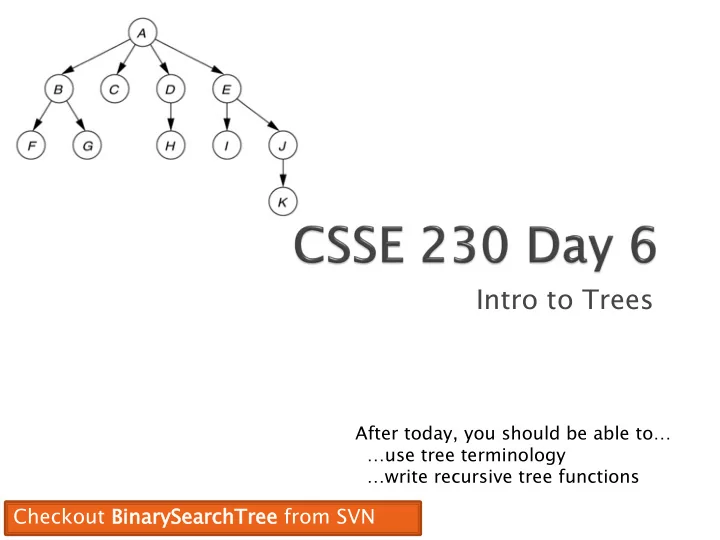

Intro to Trees After today, you should be able to… …use tree terminology …write recursive tree functions Checkout Bina narySea ySearchT chTree ree from SVN
Review yesterday’s quizzes on Java Collections and Data Structures
Part of Homework 3 ◦ Examine the Code of Ethics of the ACM Focus on property rights ◦ Write a reaction (1 page single-spaced) ◦ Details are in the assignment Context for writing efficient code ◦ Correct and maintainable, does it need to be fast? ◦ Other constraints like space ◦ Completing your work ethically ◦ Be a team player (next)
an implementation that offers interesting benefits, but is more complex to code than arrays… … Trees!
Introduction and terminology for three types Trees Binary Trees Binary Search Trees ?
Class hierarchy tree (single inheritance only) Directory tree in a file system
A collection of nodes Nodes are connected by directed edges. ◦ One special root node has no incoming edges ◦ All other nodes have exactly one incoming edge One way that Computer Scientists are odd is that our trees usually have their root at the top! How are trees like a linked list? How are they different?
Parent Child Grandparent Sibling Ancestors and descendants Proper ancestors, proper descendants Subtree Leaf, interior node Depth and height of a node Height of a tree
The height ht of a t tree is the height of its root node. Which is larger, the sum of the heights or the sum of the depths of all nodes in a tree?
A Bi Binary ary Tree is either ◦ empty ty, or ◦ consi nsists sts of: a distinguished node called the root, which contains an element, and A left subtree T L , which is a binary tree root A right subtree T R , which is a binary tree Bi Binary ary trees contain at most 2 children T L T R
Q: What property enables us to search BSTs efficiently? A: Every element in the left subtree is smaller than the root, and every element in the right subtree is larger than the root. And this is true at eve very ry node de, not just the root.
Write size() for linked list ◦ Non-recursively ◦ Recursively Write size() for a tree ◦ Recursively ◦ Non-recursively (later)
Let’s start the BinarySearchTrees assignment: implement a BinaryTree<T> class Test tree: A single tiny recursive method for 1 size will touch eve very y node in the tree. 4 2 Let’s write, then watch in debugger. 5 3 6
Recommend
More recommend